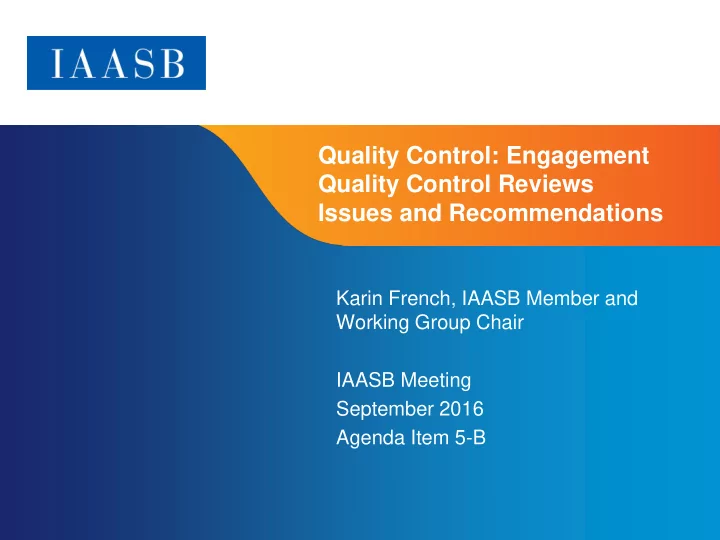

Quality Control: Engagement Quality Control Reviews Issues and Recommendations Karin French, IAASB Member and Working Group Chair IAASB Meeting September 2016 Agenda Item 5-B Page 1
CAG Feedback • Agree the determination of which engagements are subject to EQC reviews needs to be strengthened to enhance trust, but question of how – mixed views whether it should be: – PIE or – Risk-based approach supported by robust criteria • Support for establishing an objective, general steer towards it being both a firm- level and engagement-level control • Depth of the EQC review – mixed views as to whether it should be focused on significant judgments or broader to allow EQC reviewer to exercise judgment in what needs to be considered • Timeliness of EQC review important • Transparency in the auditor’s report – mixed views – some believe information is relevant to investors, others agree with WG’s conclusions Page 2
CAG Feedback • Agree with no interaction between EQC reviewer and TCWG • Selection of EQC reviewer important, support for the competencies. Consider authority, independence of EQC reviewer and inappropriate influence from client. – Firm “tone and culture” towards EQC review - status within the firm – Cooling-off – mixed views whether prescriptive or not • Separate standard – agree that this should be considered at a later stage Page 3
Question 1: Extending the EQC Review to Entities Beyond Listed Entities General Is there agreement that there is support to strengthen the requirements for an EQC review beyond listed entities? Prescriptive requirements Should the requirement for an EQC review be prescriptive? If so, should it be: • PIE’s, for example the IESBA definition; • Another definition determined for the purposes of ISQC 1; or • Specified entities such as banks or insurance entities? If this is extended to specific types of entities such as banks and insurance entities, are there any other types of entities that should be considered? Page 4
Question 1 & 2: Extending the Engagement Quality Control (EQC) Review to Entities Beyond Listed Entities Firm’s consideration of engagements subject to EQC review 1(c). Should the existing requirements be strengthened for the firm’s consideration of engagements that should be subject to an EQC review, through a risk- based approach supported by robust criteria? 2. With regards to the possible minimum criteria identified in paragraph 31: • What are the IAASB’s views regarding the criteria identified? • Are there any further criteria that should be considered? Page 5
Question 3 and 4: Objective of the EQC Review (a) Should an objective for the EQC review should be determined and included in the standards? (b) If yes, should the objective for the EQC review be: • A firm-level objective (alternative 1); • An engagement-level objective (alternative 2); or • A combination of both (alternative 3)? Engagement level objective Should the engagement level objective: • Focus more specifically on the significant judgments made by the engagement team; or • Be broader than significant judgments? Page 6
Question 5: Transparency and Interactions with TCWG Does the IAASB agree that no further actions are necessary relating to: • Transparency in the auditor’s report regarding the EQC review; • Addressing the interactions between the EQC reviewer and TCWG? Page 7
Question 6: Eligibility of the EQC Reviewer The IAASB is asked for their views regarding: • The appropriateness of the additional requirements that would be established for listed entities. • The knowledge and competence that is required to serve as the engagement partner on the audit that would be considered relevant to the performance of the EQC review. Page 8
Question 7: Cooling-off Period (a) Does the IAASB agree that IESBA be informed of the developing views, and that appropriate coordination with IESBA be determined once the WG and the IAASB’s discussions have further advanced? (b) The IAASB is asked for their views regarding whether: • A prescriptive period is appropriate, • It should be a requirement for the firm to establish a policy regarding a cooling-off period, or • A more flexible risk-based approach is appropriate. Page 9
Question 8: Separate EQC Review Standard Does the IAASB agree that a separate EQC review standard should be considered at a later stage once the WG has considered the remaining issues regarding EQC reviews and the impact of three separate ISQC standards (should the IAASB determine this to be an appropriate way forward)? Page 10
www.iaasb.org
Recommend
More recommend